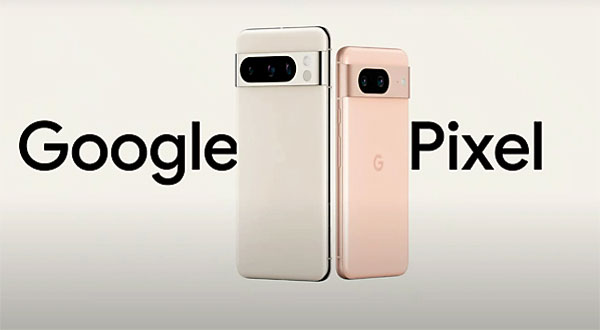Seven years of support from Google
View(s):By Mahesh de Andrado
A few weeks ago, Google unveiled their next line-up of mobile devices – the Google Pixel 8 and Google Pixel 8 Pro. Both ship out of the box with Android 14, bringing a slew of under the hood optimisations and improvements to AI to make our lives easier.
The Pixel 8
Now in its 8th iteration of smartphone, the Google Pixel 8 improves upon its already competitive photo and video quality and features. Obviously there’s focus on the camera. Pixel 8 packs a 50 MP, f/1.7 lens with Laser AF and OIS along with a 12 MP, f/2.2 ultrawide lens. The design basically looks like a more streamlined version of the Pixel 6 and 7 with the now presumably here to stay metal camera rail on the back. There’s a 6.2” OLED 120Hz, HDR10+ display with a brightness of quite an impressive 1400 nits and a whopping 2000 nits at peak brightness meaning you won’t have any problems seeing your phone’s screen even on the brightest of days. The edges are rounder, making the phone easier to grip as well as giving it a boost in terms of aesthetics.
The Pixel 8 also comes with up to 256GB of non-expandable storage and 8GB of RAM, and packs a 4575mAh battery capable of wired charging at 27W, and wireless charging at 18W. It also has reverse wireless charging so you can charge other wireless devices such as your bluetooth earbuds or smartwatch or even another Pixel 8.
It also significantly improves photo and video processing. For example, the Magic Eraser allows you to completely change an image by moving subjects around and changing backgrounds. Then there’s Best Take. Think of it as an improved top shot feature where the Pixel 8 will combine images taken from a series to make sure that everyone is looking at the camera and smiling at the same time.
The brains behind the operation is, of course, the all new Tensor G3 chip on a 4nm process with a total of 9 CPU cores. The upgraded processor will allow the Pixel 8 to use features like real time ray-tracing, AV1 encoding, and a significant boost to NLP (natural language processing) tasks as well as other AI related workloads. New features in the keyboard and recorder app allow you to effortlessly switch languages when using voice transcription and you can even ask your Pixel 8 to translate a website and read it aloud to you.
You can also ask Google Assistant (with upcoming Bard integration) to provide bullet point summaries for sites in the Google app and Chrome browser, similar to how Bard and other online AI assistants work on the desktop. Long story short, the Tensor G3 is by far the most powerful chip by Google.
The Pixel 8 Pro adds to this
So what happens when you supercharge a Pixel 8? Yep, you get a Pixel 8 Pro. It uses the same Tensor G3 chip, but has a bigger, brighter, stronger display, and ramped up camera system too. We’re talking 50MP main lens, 48MP Telephoto lens with 5x optical zoom and a 48MP Ultrawide lens. There’s an improvement to the battery as well. The Pixel 8 Pro gets a 5050mAh battery capable of charging at 30W wired, and 23W via a supported wireless charger. In addition, the Pixel 8 Pro also gets Video Boost. Think of it as night sight mode, but now for video. By using AI processing on Google’s data centres, the Pixel 8 Pro can significantly increase image quality.
Video Boost will capture details from both low-light and bright areas of a scene, and then combine them both. So basically once you shoot a photo or video, it gets processed by the Tensor G3 on the Pixel 8, then gets processed by Google’s Data centres, and the end result ends up in your Google Photos app.
The Pixel 8 Pro (for some weird reason) also adds a temperature sensor to the camera bar. According to Google, this is to record surface temperature of objects as well as to track your body temperature and add it to either Google Fit or to the FitBit app. How effective will this be? I guess someone will have to test it out and see.
7 years of updates, really?
Google went all out, announcing 7 years of software support for the Pixel 8 and Pixel 8 Pro, as well as 7 years of replacement parts, according to Soniya Jobanputra, Director of Product Management at Google. But will the Pixel 8 and Pixel 8 Pro be able to run whatever Android version is available in 2030 with no lags or performance degradation? That remains to be seen.
The Google Pixel 8 and Google Pixel 8 Pro are now available starting at $699 for the Pixel 8 and $999 for the Pixel 8 Pro, with a fully decked out Pixel 8 Pro with 12GB of RAM and 1TB of storage costing $1,399.

Searching for that next furry family member but couldn’t find one in your area? Hitad.lk has the solution with our extensive listings of dogs for sale in Sri Lanka!


